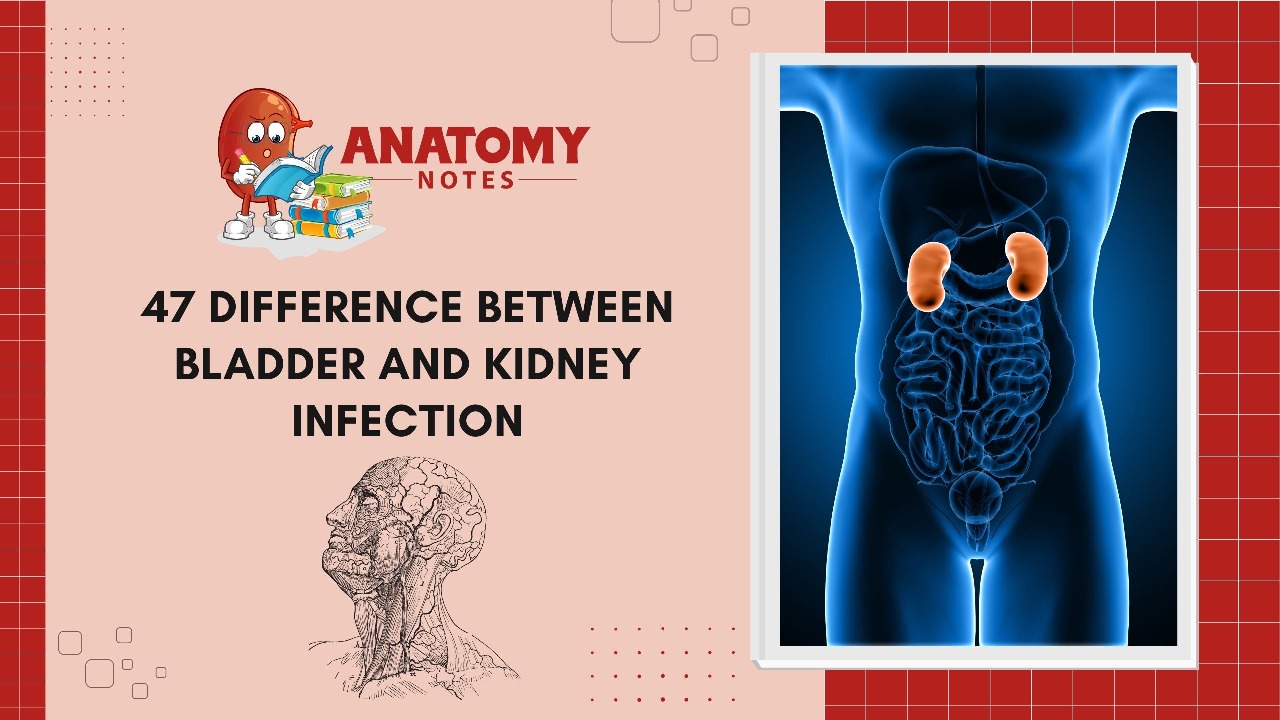Kidney and bladder infections are frequent urinary tract infections (UTIs) that can cause pain and health issues, but they differ in numerous ways. Pyelonephritis affects the kidneys, while cystitis affects the bladder. Proper diagnosis and therapy require distinguishing these two disorders.
Bladder infections begin when germs enter through the urethra. A strong need to pee, frequent and painful urination, and murky or bloody urine are common symptoms. The kidneys or circulation can get infected when germs from an untreated bladder infection move higher, offering a greater health risk. As well as UTI symptoms, kidney infections can cause lower back discomfort, fever, nausea, and vomiting.
Condition severity is another difference. Compared to kidney infections, bladder infections are less serious. Urinary infections can be uncomfortable, but if treated quickly, they seldom cause major problems. Kidney infections can cause kidney damage and systemic infections, requiring hospitalization and intravenous treatment.
Both bladder and kidney infections are diagnosed differently. Urinalysis tests urine for bacteria and white blood cells to identify bladder infections. In contrast, identifying a kidney infection usually requires blood tests, imaging exams like CT scans or ultrasounds, and a urine culture to identify the disease-causing bacteria.
These infections’ treatments differ. Oral medicines usually cure bladder infections within days. However, kidney infections typically require hospitalization and intravenous antibiotics to resolve and avoid complications. While bladder and kidney infections are urinary tract infections with similar symptoms, they differ in location, severity, diagnosis, and treatment. The kidneys are more serious than the bladder, which is less serious. Preventing problems and speeding recovery requires prompt identification and treatment for both disorders. You must see a doctor to diagnose and treat a urinary tract infection.
| S.No. | Aspect | Bladder Infection | Kidney Infection |
| 1 | Location | Affects the bladder | Affects the kidneys |
| 2 | Medical Term | Cystitis | Pyelonephritis |
| 3 | Common Symptoms | Frequent urination, pain while urinating | Fever, back pain, abdominal pain |
| 4 | Urine Changes | Hematuria (blood in urine) may be present | Hematuria is more common, often gross |
| 5 | Severity | Usually less severe | Can be more severe and may lead to sepsis |
| 6 | Risk Factors | Sexual activity, urinary retention | Urinary tract abnormalities, kidney stones |
| 7 | Bacterial Source | Escherichia coli (E. coli) most common | E. coli is common, other bacteria possible |
| 8 | Ascending Infection | Typically starts in the urethra and ascends | Often originates in the bladder and ascends |
| 9 | Complications | Rarely leads to serious complications | Can lead to kidney damage or failure |
| 10 | Diagnosis | Urinalysis and culture | Urinalysis, blood tests, imaging |
| 11 | Treatment | Antibiotics | Antibiotics, sometimes hospitalization |
| 12 | Recurrence | May recur, but less likely | Can recur, especially if underlying cause |
| 13 | Pain Location | Lower abdomen | Flank (side of the lower back) |
| 14 | Fever | Rarely associated with fever | Often accompanied by fever |
| 15 | Nausea and Vomiting | Rarely associated | Can cause nausea and vomiting |
| 16 | Impact on Kidneys | Usually does not affect the kidneys | Directly affects the kidneys |
| 17 | Impact on Bladder | Directly affects the bladder | Does not directly impact the bladder |
| 18 | Fluid Intake | May help flush out the infection | Important to maintain kidney function |
| 19 | Pain Severity | Often less severe | Can be intense and debilitating |
| 20 | Age Group Affected | Can affect people of all ages | More common in adults, less in children |
| 21 | Prevention | Good hygiene, emptying bladder regularly | Hydration, treating underlying conditions |
| 22 | Invasive Procedures | Rarely requires invasive procedures | May require more invasive treatments |
| 23 | Symptom Duration | Symptoms may resolve in a few days | Symptoms may persist longer |
| 24 | Imaging | Usually not needed for diagnosis | May require imaging (CT, ultrasound) |
| 25 | Long-Term Effects | Typically does not lead to long-term issues | Can result in kidney scarring or damage |
| 26 | Prognosis | Generally favorable with prompt treatment | Can vary depending on severity and cause |
| 27 | Impact on Daily Life | Mild impact on daily life | Can significantly affect daily activities |
| 28 | Urinary Urgency | Common | Less common, but can occur |
| 29 | Blood Pressure Changes | Usually does not affect blood pressure | Can lead to high blood pressure (hypertension) |
| 30 | Antibiotic Resistance | Less likely to develop antibiotic resistance | Risk of resistance may be higher |
| 31 | Recurrent Infections | May not be associated with recurrent UTIs | Can be a predisposing factor for UTIs |
| 32 | Dehydration Risk | Lower risk of dehydration | Higher risk of dehydration |
| 33 | Impact on Pregnancy | Usually does not affect pregnancy | Can pose risks to pregnancy and fetus |
| 34 | Surgical Intervention | Rarely requires surgery | May require surgery in severe cases |
| 35 | Immune System Response | Generally less intense immune response | More intense immune response |
| 36 | Diagnostic Challenges | Easier to diagnose based on symptoms | May require more extensive testing |
| 37 | Complications in Men | Less common in men | Can affect men and women equally |
| 38 | Risk of Sepsis | Lower risk of sepsis | Higher risk of sepsis |
| 39 | Impact on Appetite | Generally does not affect appetite | Can lead to loss of appetite |
| 40 | Treatment Duration | Shorter course of antibiotics | May require longer antibiotic treatment |
| 41 | Bloodstream Infection | Less likely to lead to bacteremia (blood infection) | Can lead to bacteremia |
| 42 | Sexually Transmitted | Not sexually transmitted | Not sexually transmitted |
| 43 | Chronic Infection Risk | Less likely to become chronic | Can lead to chronic kidney infections |
| 44 | Impact on Quality of Life | Mild to moderate impact | Can severely impact quality of life |
| 45 | Association with Diabetes | Generally not associated with diabetes | Kidney infections can complicate diabetes |
| 46 | Response to Antibiotics | Typically responds well to antibiotics | Response may vary, some strains may be resistant |
| 47 | Recurrence After Treatment | Less common recurrence after treatment | Recurrence is possible even after treatment |
Frequently Asked Questions (FAQs)
Q1: What are common bladder and kidney infection symptoms?
Common bladder infection symptoms include frequent urinating, strong urges, painful urination, and cloudy or bloody urine. Lower back discomfort, fever, nausea, and vomiting are common kidney infection symptoms along with UTI symptoms. To get proper medical care, you must know these differences.
Q2: How can I distinguish bladder and kidney infections?
Location and intensity of infection are essential. Bladder infections are usually painful but seldom serious. However, untreated kidney infections can damage the kidneys and cause systemic infections. Fever, nausea, and lower back discomfort may indicate kidney infection.
Q3: How are bladder and kidney infections diagnosed?
Urinalysis analyses urine for bacteria and white blood cells to identify bladder infections. To detect the bacteria causing kidney infections, blood tests, imaging examinations like CT scans or ultrasounds, and urine cultures are needed. Correct diagnosis is essential for therapy.
Q4: How should bladder and kidney infections be treated?
Oral medicines cure bladder infections, which normally alleviate symptoms within days. Hospitalization and intravenous antibiotics are needed for serious kidney infections to clear and avoid sequelae. Following the treatment plan and finishing antibiotics is crucial.
Q5: What happens if a bladder or kidney UTI is untreated?
Untreated bladder infections can cause kidney infections and cause pain. Untreated kidney infections can cause kidney damage and be fatal if germs enter the circulation. Preventing these consequences requires prompt diagnosis and treatment.




